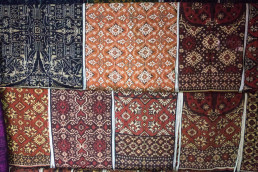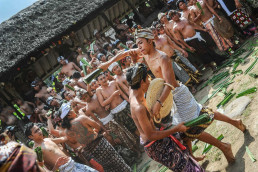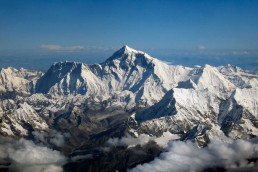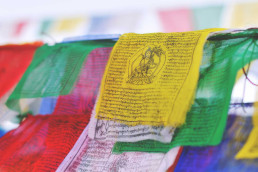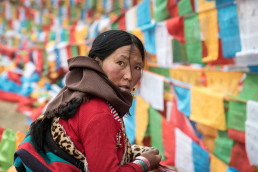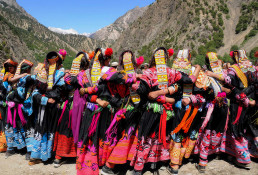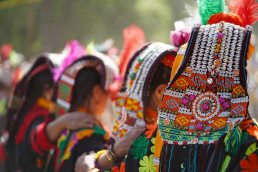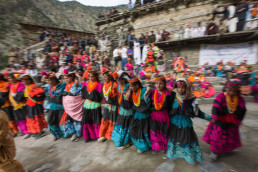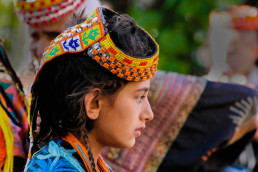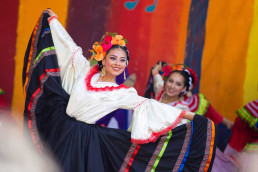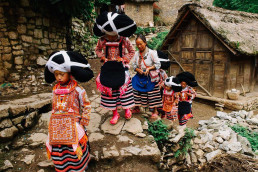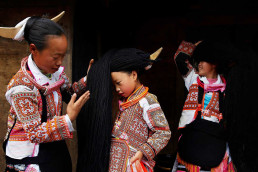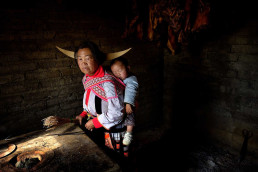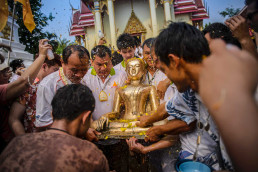The Last Stand of Bali Aga: Inside Tenganan’s Sacred Rituals
Bali, dubbed the “Island of the Gods,” is known for its lively Hindu culture, creative traditions, and breathtaking vistas. Yet, nestled among emerald rice paddies and soaring volcanoes is Tenganan, a town that whispers of Bali’s ancient past. The Bali Aga, the island’s indigenous people, preserve a distinct cultural history here, with their traditions serving as a monument to the island’s perseverance.
Walking around Tenganan is like stepping back in time. Traditional cottages with thatched roofs line tiny alleyways, and the air is dense with the sweet, intoxicating perfume of frangipani blooms mixed with the earthy aroma of woodsmoke curling from open hearths. Women, clad with elaborate silver jewellery that tinkles softly with each step, weave intricate patterns on looms, their deft fingers creating the renowned Gringsing fabric – a double-ikat textile prized for its geometric designs and symbolic importance. The repetitive clack of the looms blends with the quiet murmur of villagers greeting one another in their own accent, creating a symphony of sound that speaks of a life steeped in tradition.
The village elder, or pemangku, is a revered figure. He is the living manifestation of ancestral knowledge, the link between the spirit and physical worlds. His knowledge leads the locals, preserving the survival of their distinctive customs and practices passed down through centuries. One such activity, and the subject of this investigation, is Perang Pandan, also known as the “War of the Pandan Leaves.”
Perang Pandan is a ritualised fake fight between two groups of young men known as prajurian (warriors), rather than a violent battle. They march to the rhythmic beat of gongs and drums, dressed in brilliant red and white sashes, their faces painted with bold decorations that ward off evil spirits while also symbolising their inner strength. The air crackles with excitement as they brandish shields made of aromatic pandan leaves and participate in a lively exchange of blows, their laughter booming throughout the town.
However, beneath the whimsical veneer, there is a deeper importance. Perang Pandan is a symbolic depiction of the eternal conflict between good and evil, or “desa” and “kala” in the local language. The red sashes represent the fiery spirit of the protecting deities, the barong, who guard the hamlet and preserve its prosperity. White symbolises purity and the benefits of the rice deity Dewi Sri. The ceremony is designed to pacify the negative powers that threaten harmony and keep the delicate balance between the physical and spiritual realms.
The exact roots of Perang Pandan are lost in time. Some believe it is a vestige of a bygone era, a ritualised reenactment of historical wars conducted to protect the community from invasion. Legends tell of a time when the Bali Aga vehemently opposed assimilation by neighbouring kingdoms, its warriors brandishing sharpened bamboo spears rather than pandan leaves. Others regard it as a fertility rite to ensure a plentiful harvest and the survival of the Bali Aga bloodline. Regardless of its historical origins, Perang Pandan plays an important duty in Tenganan today.
The ceremony instills a sense of camaraderie and belonging among the young men. As they train for weeks before the event, they form ties that transcend individual differences. The brotherhood that develops during this time prepares them not just for the mock war, but also for their future duties as community protectors and leaders. It is a rite of passage, a visible expression of their dedication to carrying on their ancestors’ traditions.
Witnessing Perang Pandan provides a window into Tenganan’s soul and demonstrates the Bali Aga people’s enduring legacy. Their unshakable adherence to their traditions means that a bright piece of Bali’s historical history lives on in the present era. Walking through the vivid display, with rhythmic drumming ringing in your ears and the aroma of pandan leaves filling your senses, you develop a better understanding for the strength of a culture that has weathered the test of time. The experience goes beyond mere observation; it is an emotional connection to a society in whom the past is not a lost relic, but a live thread woven into their present.
Goddess Mother’s Guardians: How Sherpas Conquer Everest’s Perils
Mount Everest, the world’s highest peak, rises 8,848 metre above the ground. Its snowy slopes tell stories of daring expeditions, stoic traditions, and the steadfast spirit of the Sherpas. For millennia, the Sherpas, an ethnic minority from the Khumbu region, have considered Everest massive home. Their lives are inextricably linked with the mountain, which they venerate as Chomolungma, “Goddess Mother of the World.”
The first reported European attempt on Everest was in 1921. These early trips were primarily reconnaissance efforts, testing the mountain’s defences and scouting possible paths. Success depended on the Sherpas’ knowledge and fortitude. Their extensive knowledge of the perilous Khumbu Icefall, a vast area of crevasses and glacier debris guarding Everest’s foot, proved vital. They transported supplies, set up camps, and marked pathways through the treacherous terrain, all while braving the harsh weather at high altitude. Tenzing Norgay, the great Sherpa mountaineer, exemplified Sherpa resilience. He took part in multiple excursions during the 1930s and 1950s, honing his skills and understanding of Everest. In 1953, he and Edmund Hillary, a New Zealand climber, became the first humans to reach the peak. This epic ascent not only marked a watershed moment in mountaineering, but it also propelled the Sherpas into the international spotlight, forever altering their status on Everest.
Today, Everest draws a new type of adventurer. Commercial expeditions have made the summit accessible to a broader variety of climbers, from experienced mountaineers to individuals seeking a once-in-a-lifetime challenge. Nonetheless, the trek remains perilous. The harsh “death zone” at 8,000 metre, with its freezing temperatures and oxygen-depleted environment, continues to claim lives. It is here that the Sherpas’ abilities are most important. They repair ropes, the lifelines that let climbers to safely ascend and descend, set up camps that give critical shelter at high elevations, and lead climbers through dangerous areas like as the Hillary Step, a near-vertical rock wall. They bear enormous responsibility for the expedition’s success – and, in many cases, its survival.
Everest, however, is not impervious to change. Climate change is dramatically changing the mountain scenery. Rising temperatures have accelerated glacier melt, resulting in hazardous icefalls and unpredictable weather patterns. The once-predictable climbing season is becoming more irregular, with shorter periods of clear weather and more powerful storms. The Khumbu Icefall, formerly a severe but manageable challenge, has become a dynamic maze of crevasses and sliding ice seracs, posing a considerable threat to climbers. Melting permafrost reveals previously buried dead, creating ethical concerns about how to manage the mountain’s dark history. Sherpas’ ropes can freeze in place, becoming lethal snares for climbers.
The future of Everest is unknown. However, one thing is certain: Sherpas will continue to play an important role. Their strong ties to the mountain, passed down through generations, and steadfast spirit are as important to Everest’s tale as the majestic peaks itself. They are the mountain’s gatekeepers, and they know its moods and secrets. As Everest faces the challenges of a changing climate, the Sherpas’ knowledge and adaptability will be more valuable than ever.
A Full Moon Fiesta: Witnessing the Culmination of Saga Dawa
During Saga Dawa, there is silence in the Himalayas, as prayer flags wave in the wind against the background of snow-capped mountains. For Tibetan Buddhists, this most sacred festival is more than just a party; it’s also a pilgrimage, a commitment to doing good deeds, and a colourful spectacle celebrating Gautama Buddha’s life.
Saga Dawa is a very important event that takes place on the 15th day of the fourth month in the Tibetan lunar calendar, which is typically in May or June. It corresponds to the three major moments in the life of the Buddha: his birth, his enlightenment under the Bodhi tree in Bodh Gaya, and Parinirvana, his ultimate release from the cycle of rebirth.
The core idea of Saga Dawa is achieving merit. Pilgrims walk the ancient walls of holy places like Lhasa’s Jokhang Temple, snapping prayer flags in the cool mountain air as they go. The cries reverberate through the valleys as the masses undergo tangible manifestations of their devotion in the form of protests.
Ceremonies bring monasteries like Tashilhunpo, which sits majestically atop a hill, to life. The halls resound with the recitation of holy passages from worn-out manuscripts by monks in maroon robes. Intricate murals portraying the life of the Buddha are illuminated by butter lamps, which represent the dispelling of ignorance. To show their appreciation for the Buddha’s teachings, they offer bowls filled with fresh fruits and colourful mandalas made from rice flour.
Life outside of monasteries is not immune to the influence of Saga Dawa. One way to gain merit is to do good deeds, such as giving to the poor or freeing shackled animals. The social fabric is enriched by this ideology, which in turn cultivates the characteristic kindness and compassion of the Tibetan people.
Under the expansive Himalayan sky, local families come together for picnics, where they share food and stories that have been passed down through the years. A one-of-a-kind symphony emerges when the sound of laughter blends with the faint sound of prayers. Exuberant bursts of colour and movement characterise traditional performances such as Cham dances, which portray themes from Buddhist mythology. The evocative sounds of lengthy horns and repetitive cymbal crashes take listeners back in time.
The full moon day marks the end of Saga Dawa. With the help of hundreds of dancing butter lights, Lhasa’s Potala Palace—the previous home of the Dalai Lama—becomes a shining symbol. The streets are filled with worshippers, some of whom release lanterns into the sky to send prayers floating up into the heavens. An electric energy, a powerful blend of spiritual enlightenment and joyful celebration, permeates the air.
At Saga Dawa, you will have a profound spiritual experience; it is more than just a celebration. Here is an opportunity to follow in the Buddha’s compassionate footsteps, embrace all beings with kindness, and create positive karma for a brighter future. It’s a lively reflection of the Buddha’s life’s lasting influence on millions of people in the Himalayas, inviting visitors to partake in this one-of-a-kind and profoundly significant festival. If you are looking for an insight into the core of Tibetan Buddhism, Saga Dawa provides one. It shows a culture that is very religious, very traditional, and quite kind.
Love, Music, and Mountain Gods: Pakistan's Enchanting Chilam Joshi Festival
A compelling human narrative unfolds high in Pakistan’s Hindu Kush mountains, where snow-capped peaks break the clear blue sky. The Kalash people live here, in the steep valleys etched by time, a dynamic community with a fascinating history. Their origins are shrouded in mystery, and they continue to pique interest. Some stories hint at a link to the legendary Alexander the Great’s army, but others go further, implying an even older ancestry rooted in animistic beliefs. Regardless of their origins, the Kalash have cut a distinct path across this harsh terrain, retaining a way of life unlike any other in the region. Their unique language and adherence to a polytheistic belief system centred on deities such as the benign Goshidai distinguish them as a cultural island, demonstrating the continuing strength of tradition. Every year, as the severe winter fades and spring paints the valleys in a kaleidoscope of colours, the Kalash celebrate Chilam Joshi, their beautiful New Year festival.
The Chilam Joshi Festival, a four-day celebration of the Kalash New Year, takes place every year as spring arrives. Chilam Joshi, which takes place from May 13 to 16, is a brilliant riot of colour, song, and culture. This joyful event serves as a twin offering: a time to thank the gods for a bountiful crop and a venue for young Kalash men and women to meet potential life partners.
The festivities begin with a day of blessings. Known as “Milk Day,” families assemble to make milk sacrifices as a symbolic gesture to their deity, Goshidai, in exchange for livestock protection and a successful crop season. As the days progress, the air is filled with expectancy. Women dress up in beautiful new outfits, their headpieces embellished with elaborate embroidery and cowrie shells. The valleys come alive with the rhythmic rhythms of drums and the soulful sounds of flutes, bringing people together for joyous dances.
The vivid dance routines in Chilam Joshi are one of the show’s most appealing qualities. Young men and women, dressed in their finest apparel, create circles and move with contagious energy, their steps matching nature’s cyclical rhythm and the promise of a prosperous spring. As the days pass, a sense of community pervades the air. Laughter blends with the music, tales are shared, and potential couples engage in playful conversation as a prelude to life-changing decisions.
By the festival’s end, announcements of successful courtship matches add a layer of joy to the festive atmosphere. Chilam Joshi is more than just a springtime festival; it’s a vivid tapestry of faith, community, and hope for a successful future. Witnessing this one-of-a-kind celebration provides an insight into the heart of the Kalash culture, allowing you to be charmed by their traditions and the unyielding spirit that has enabled them to thrive for centuries.
Beyond Tacos: The Inspiring Legacy of Cinco de Mayo
Cinco de Mayo. Many people associate it with colourful parades, piñatas, and delicious tacos. But beneath the surface of this seemingly frivolous celebration has a deeper historical significance, which is frequently buried by the party atmosphere. Let’s look at the true story of Cinco de Mayo, a tale of resilience, national pride, and an underdog victory that has resonated across cultures.
In the early 1860s, Mexico was in a vulnerable condition. Years of political instability, along with a faltering economy, prompted President Benito Juarez, a Zapotec lawyer who championed indigenous rights, to stop foreign loan repayments. This decision infuriated European nations such as France, Britain, and Spain, who viewed it as an insult. They sent troops to Mexico and demanded repayment at gunpoint. Britain and Spain quickly withdrew, terrified of more bloodshed. However, France, led by the ambitious Napoleon III, saw an opportunity. He planned to install a puppet monarch in Mexico, Maximilian of Austria, and establish a French colony in the Americas, a move that would directly threaten the expanding strength of the United States.
On May 5, 1862, a motley Mexican army led by General Ignacio Zaragoza faced a seemingly impossible challenge: a well-armed and battle-hardened French force. Despite being heavily outnumbered and outgunned, the Mexican troops, driven by patriotism and a desire for sovereignty, defended Puebla with unshakable devotion. In a surprising upset, they humiliated the French. The win at Puebla was a watershed moment, a symbolic triumph that lifted Mexican morale and displayed their unyielding resolve. However, it’s worth noting that it wasn’t a decisive victory. The French regrouped and eventually took over Mexico City, installing Maximilian. The struggle for Mexican independence would last several years, but the Battle of Puebla stood as a beacon of hope, demonstrating that a determined people could defeat even the most fearsome foe.
While Cinco de Mayo is celebrated predominantly in the state of Puebla, the event has gained popularity north of the border. Mexican-American communities in the United States celebrated Cinco de Mayo as a symbol of resistance against oppression and a celebration of their ancestry. Cinco de Mayo became a rallying point for the Chicano civil rights movement in the 1960s, emphasising Mexican culture’s challenges and successes. This cultural interaction has increased the holiday’s significance by encouraging a greater understanding for Mexican history and traditions in the United States.
Today, Cinco de Mayo serves as a reminder of the human spirit’s resilience in the face of hardship. It’s an opportunity to explore the rich fabric of Mexican culture, from its vibrant music and dance traditions to its wonderful gastronomy, which extends far beyond tacos. Sample regional specialties such as mole poblano, a complex sauce from Puebla, or learn about the rich history of mariachi music, which combines indigenous and European traditions. So, this Cinco de Mayo, take a time to look past the joyful exterior and delve into the deeper meaning of this historical day. Immerse yourself in the rich culture, savour the distinct flavours, and recall the inspiring story of resilience that this day commemorates.
Cinco de Mayo’s tale demonstrates a people’s unbreakable spirit as they strive for their freedom and sovereignty. It’s a story about courage, sacrifice, and the triumph of the underdog against enormous odds. Despite the passage of time, Cinco de Mayo remains an important emblem of resilience and cultural pride. As we commemorate this yearly event, let us remember the lessons it teaches us about the power of the human spirit and the significance of standing up for what we believe in. So raise a toast to Puebla’s heroes, and may their legacy continue to inspire future generations.
May the Fourth Be With You
Every year on May 4th, a galaxy far, far away bursts into our living rooms, convention halls, and social media pages. This is more than just another franchise anniversary; it’s Star Wars Day, a worldwide phenomenon that spans generations and cultures. But how did a space opera become such a dominant force in popular culture?
The origins of Star Wars Day are as deliciously geeky as the franchise itself. In 1979, a congratulatory greeting to newly elected British Prime Minister Margaret Thatcher included the phrase “May the Fourth Be With You,” a play on the Jedi Knight’s well-wishes, “May the Force be with you.” The internet, which was still in its early stages, seized on the joke, and Star Wars Day was created.
However, Star Wars Day is about more than just clever wordplay. It’s a celebration of a vast universe full of unique characters, amazing experiences, and timeless concepts. Star Wars connects with fans on a deeply emotional level, from the epic lightsaber battles between good and evil to the endearing friendship between a young farmboy and an elderly mentor.
The influence of Star Wars on popular culture is evident. It transformed special effects, resulting in breathtaking sights that transported spectators to a galaxy unlike any seen before. George Lucas developed Industrial Light and Magic (ILM), which became a powerhouse in the business by pushing the boundaries of what was possible on screen. Star Wars’ pioneering special effects not only wowed spectators in 1977, but also ushered in a new era of cinematic narrative.
The franchise’s renowned soundtrack scores, composed by John Williams, have become deeply embedded in our national psyche. The dramatic orchestral arrangements wonderfully portray the space opera’s enormous scale, rebel heroism, and the Empire’s terrible might. From the triumphant swells of the “Star Wars Theme” to the foreboding chords of the Imperial March, Williams’ music is as integral to the Star Wars experience as the lightsabers and X-wings.
However, Star Wars’ reach stretches well beyond the screen. It has fueled a devoted global fan base that enjoys cosplay conventions, fan art, and internet communities. These fans’ passion is legendary, with some making elaborate costumes, highly detailed models, and even producing their own Star Wars-inspired musical pieces. The narrative has spawned numerous books, comic books, computer games, and even theme park attractions. The Mandalorian, Disney+’s blockbuster series, demonstrates that the Star Wars universe is ready for further exploration, with new tales and characters enthralling new generations.
Star Wars Day showcases the power of narrative. It’s a day to honour the franchise’s enduring heritage, which has sparked imaginations, built communities, and left an indelible imprint on popular culture. So, on May 4th, grab your lightsaber (or glow stick), raise a glass of blue milk (or your favourite beverage) and join the world’s celebration of a galaxy far, far away. After all, May Fourth be with you!
Celebrating Jazz Day and Duke Ellington's Timeless Influence
In the melodious fabric of history, Jazz Day is a thunderous celebration of rhythm, culture, and the ongoing legacy of musical virtuosos. At its centre is the mysterious figure of Duke Ellington, a maestro whose unprecedented talents have shaped the very essence of jazz.
Jazz Day, an annual global festival held on April 30th, is a symphony of cultural diversity and creative expression. It crosses geographical boundaries, bringing fans and performers together in a beautiful crescendo of jazz appreciation. As fans immerse themselves in the soulful melodies and improvisational genius of this music, they also honour the giants that pioneered its glorious path.
Among the constellation of jazz legends, Duke Ellington stands out as a beacon of creativity and originality. Born Edward Kennedy Ellington in 1899, he rose from the thriving jazz environment of Harlem, New York, to revolutionise the genre with his unique style and exceptional musical ability.
Duke Ellington’s effect on jazz goes beyond mere musical creativity; it represents a cultural phenomenon. His works, including “Take the ‘A’ Train” and “Mood Indigo,” have a timeless fascination that captivates listeners of all ages. With his orchestra, the Duke Ellington Band, he created a symphonic tapestry that effortlessly interweaved elements of blues, swing, and classical music, pushing the boundaries of jazz.
Duke Ellington’s legacy reaches well beyond the limitations of his time. His revolutionary arrangements, which feature rich harmonies and virtuosity improvisation, continue to inspire and enchant musicians around the world. From dark jazz clubs to enormous concert halls, his melodies reverberate, reminding us of music’s transforming power to break down barriers and bring people together.
Jazz Day commemorates not only the past but also the future of this uniquely American musical form. Duke Ellington’s legacy acts as a beacon, encouraging new musicians to forge their own paths while remaining true to the heart of jazz. Jazz Day builds a global community through festivals, concerts, and educational projects that share a passion for music and cultural exchange.
In the annals of musical history, Duke Ellington stands as a colossus, a pioneer whose innovative spirit continues to reverberate through the corridors of time. His unparalleled contributions to jazz not only shaped the genre but also enriched the cultural fabric of society. As we commemorate Jazz Day and pay tribute to Ellington’s legacy, we reaffirm our commitment to preserving and perpetuating the rich tapestry of jazz for generations to come.
In the symphony of life, Jazz Day serves as a poignant reminder of the transformative power of music to inspire, unite, and transcend. And in the immortal words of Duke Ellington himself, “It don’t mean a thing if it ain’t got that swing.”
Festival In The Highlands: Miao Sister's Meal Festival
A world steeped in tradition and time-honored customs awaits you in China’s Guizhou province, nestled among verdant mountains and flowing rivers. This is home to the Miao people, a vibrant ethnic group with a rich history. Among their various customs, one stands out for its color, music, and communal spirit – the Miao Sisters’ Festival.
The Miao Sisters’ Festival, locally known as the ‘Miao Sisters’ Meal’, is a grand event that takes place annually in the spring. It is a time when the Miao people gather in their traditional silver ornaments and brightly coloured attire to celebrate their shared heritage and strengthen their communal bonds.
The festival is named after the legendary Miao sisters, whose story of love and sacrifice is deeply ingrained in the Miao folklore. The sisters, it is said, used their wisdom and courage to save their people from a great calamity. Today, their spirit lives on in the festival that bears their name.
The Miao Sisters’ Festival is a feast for the senses. The air is filled with the melodious sounds of Lusheng, a traditional Miao musical instrument. The vibrant colors of the Miao attire, coupled with the shimmering silver jewelry, create a visual spectacle that is nothing short of mesmerizing.
But the festival is not just about music and dance. It’s also a time for the Miao people to showcase their culinary skills. The ‘Sisters’ Rice’, a special dish prepared only during the festival, is a highlight of the event. Made from glutinous rice and dyed with natural colours, the dish represents the Miao people’s close relationship with nature.
The Miao Sisters Festival is more than just a cultural celebration. It demonstrates the Miao people’s resilience and unwavering commitment to preserving their traditions. It’s a window into a world that, despite the onslaught of modernity, continues to hold on to its roots.
So, if you’re a traveler with a keen interest in culture and tradition, make sure to mark your calendar for the Miao Sisters’ Festival. It’s an experience that promises to be as enriching as it is unforgettable.
In the end, the Miao Sisters’ Festival is a celebration of life, love, and community. It’s a reminder that in a world that’s constantly changing, some things remain timeless. And it’s these timeless traditions that make our world a more colorful and vibrant place. So come, take a journey through time, and experience the magic of the Miao Sisters’ Festival.
Miao Tribe : A Symphony Of Tradition And Culture
Amidst the stunning breadth of Southern China and Southeast Asia’s mountainous terrains, the Miao people present a rich tableau of cultural heritage and historical tale. The Miao are revered as one of the 56 sanctioned ethnic groupings recognised by the Chinese government, and they find refuge among the steep crests of provinces like as Guizhou, Yunnan, Sichuan, Hubei, Hunan, Guangxi, Guangdong, and Hainan. Their presence, however, crosses borders, penetrating the beautiful landscapes of Vietnam, Laos, Myanmar, and Thailand, where their population, estimated to be between 9 and 12 million, whispers stories of their long impact.
Within the Miao realm, the term “Miao” becomes a prism refracting diverse cultural facets, encompassing the Hmu of southeast Guizhou, the Qo Xiong of western Hunan, the A-Hmao of Yunnan, and the Hmong, whose ethereal essence weaves through the fabric of Guizhou, Sichuan, Guangxi, and Yunnan. Each constituent group, linked by linguistic strands, unravels a unique tapestry of customs, histories, and dialects, creating a rich portrait of cultural complexities.
The heart of Miao existence beats with a symphony of colours and harmonies, manifested in their age-old dances—an exquisite choreography echoing with the echoes of their cultural ancestry. Adorned in glittering silver jewellery and enrobed in intricate needlework, Miao costume serves as a canvas for their tale, demonstrating their aesthetic prowess and devotion for tradition.
Miao culture thrives on folk spirituality, which is rooted in their ancestral beliefs. As protectors of animistic realms and curators of ancestral tribute, the Miao travel across a spiritual environment abounding with countless spirits, led by shamans who organise rites to appease ethereal creatures or summon the healing essence for the wounded soul. In solemn rituals, animal sacrifices symbolise the Miao’s fundamental connectedness with the natural world, creating a tapestry of reverence for life’s cyclical movement.
Despite the winds of change, the Miao continue to be land stewards, their agrarian traditions inextricably linked to the earth’s rhythms. As they transition from nomadic cultivation to permanent agrarian methods, they cultivate an abundance of market garden products, symbolising their persistence in the face of modernity’s encroachment—a monument to their adaptability and enduring tenacity.
Miao hospitality is based on an attitude of warmth and camaraderie, with guests greeted with open arms and magnificent feasts embellished with poultry gifts and horn spirit libations—a ritualistic communion that reflects their love for social relationships and ancestral traditions.
The fabric of Miao existence is a kaleidoscope of colours, a symphony of traditions—a living witness to the indomitable spirit of a people whose story spans the ages. Despite the ebb and flow of millennia, the Miao remain a beacon of cultural history, showing the path of human perseverance and the lasting legacy of ancient wisdom.
The Vibrant Traditions of Songkran Festival
The Songkran Festival, held annually from 13 to 15 April, commemorates the traditional Thai New Year. Songkran, derived from the Sanskrit word’saṃkrānti’, meaning ‘to walk into’ or ‘pass into’, represents the astrological transition from one zodiac sphere to another. This celebration is strongly established in Thai tradition and represents purification, regeneration, and the metaphorical washing away of negativity.
Songkran is extremely important in Thai culture since it is a time for spiritual cleaning and renewal. The event allows people to honour their ancestors, make merit at temples, and spend time with loved ones. It is a moment to reflect on the previous year, let go of negativity, and embrace the new year with hope and optimism.
The first day of the holiday, known as Songkran Day, sees people cleaning their houses and public sites such as temples and schools to clear out any bad luck from the previous year and prepare for the new year. Another major activity is Song Nam Phra, a ritual in which fragrant water is poured over a temple’s precious Buddha images.
The second day, known as Wan Nao, is spent preparing food and offerings to be offered to monks and temples the next day. It is also a time to pay respect to elders, and young people prepare rose and jasmine water, as well as Nam Op-scented water, to wash their parents’ feet in a ceremony known as Rot Nam Dam Hua. In exchange, the parents bless the children, usually with a jasmine floral garland.
The annual Songkran encourages community collaboration, unity, and forgiveness. It is seen as a time to symbolically wash away misfortunes, pray for prosperity in the next year, reunite with family members, and remember ancestors and the elderly.
The festival is especially known for its water battles, which have gained popularity among both Thais and foreigners. Soaking someone in water is a Thai ritual that represents clearing off harmful deeds and thoughts. During Songkran, splashing water is thought to bring good health, prosperity, longevity, and good fortune.
Songkran’s significance extends beyond the scope of a single festival. It shapes Thailand’s cultural identity and how the rest of the world perceives this dynamic country. The festival’s global recognition, including its recent designation by UNESCO as a “intangible cultural heritage of humanity, demonstrates its cultural relevance and global effect.
In conclusion, the Songkran Festival is a significant cultural event that captures the essence of Thai culture and tradition. Its influence goes beyond Thailand’s boundaries, shaping global impressions of Thai culture and instilling a sense of unity and rebirth. As we celebrate Songkran, we are reminded of the value of cultural preservation, mutual respect, and the delight of sharing human experiences.

